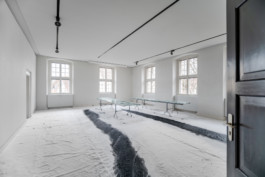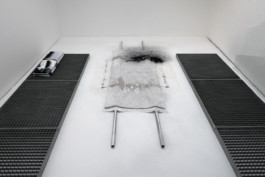matej bosnić - m.bosnic(at)posteo.net - about
Through a variety of strategies and media, the artworks of Matej Bosnić inquiry the perception of space and its entanglements with past experiential echoes. More than often, his site-specific installations transpose the memory of personal occurrences into universal pattern recognitions in both psychological and anthropological sense.
Moving from traditional figurative painting and drawing, Matej Bosnić’s practice has radically shifted to the observation of a given area and the re-elaboration of its less obvious details, progressively revealing their unnoticed presence through immersive installations that can be perceived as “improvisational sites”. On the one hand, the room sets the tones for how his disseminated spatial interventions, born within the location itself, amplify and modulate pre-existing yet tacit elements. On the other hand, the modes of selection and artistic agency create a radically new atmosphere aiming to resonate with one’s own thoughts, feelings and memories, thus exploring its limits and possibilities.
Like evidences of a story that can’t be fully reconstructed, his interventions elicit the visitor’s personal deductions, bridging the gaps between spatial perception, ambience, and individual experiences.
History, like memories and dreams, are not made of clearly delineated narratives but are a constellations of fragmented details that generate atmospheres, like echoes that resonates beyond the clap that originated them. At the core of Bosnić’s research is the concept of ambience and of the pauses, the empty spaces between the subtle details that constitute it: inspired by his childhood in Croatia, surrounded by traces of a war never experienced directly, his practice inquires the nature of these marks ‘of the absence of a presence’, as Derrida would define them.
Rather than haunting nostalgia, these empty pauses between signs unfold the poetic of pure potentiality, the ungraspable yet-to-come in the form of atmosphere. How does a space feel like when you enter it? Which personal pattern recognitions are activated through the immersion in a certain environment? Is this intimate and resonance an anthropological common ambiance that unite us and, ultimately, isn’t this play between identity and difference the precondition of thought and experience?
Giada Dalla Bonta
Through a variety of strategies and media, the artworks of Matej Bosnić inquiry the perception of space and its entanglements with past experiential echoes. More than often, his site-specific installations transpose the memory of personal occurrences into universal pattern recognitions in both psychological and anthropological sense.
Moving from traditional figurative painting and drawing, Matej Bosnić’s practice has radically shifted to the observation of a given area and the re-elaboration of its less obvious details, progressively revealing their unnoticed presence through immersive installations that can be perceived as “improvisational sites”. On the one hand, the room sets the tones for how his disseminated spatial interventions, born within the location itself, amplify and modulate pre-existing yet tacit elements. On the other hand, the modes of selection and artistic agency create a radically new atmosphere aiming to resonate with one’s own thoughts, feelings and memories, thus exploring its limits and possibilities.
Like evidences of a story that can’t be fully reconstructed, his interventions elicit the visitor’s personal deductions, bridging the gaps between spatial perception, ambience, and individual experiences.
History, like memories and dreams, are not made of clearly delineated narratives but are a constellations of fragmented details that generate atmospheres, like echoes that resonates beyond the clap that originated them. At the core of Bosnić’s research is the concept of ambience and of the pauses, the empty spaces between the subtle details that constitute it: inspired by his childhood in Croatia, surrounded by traces of a war never experienced directly, his practice inquires the nature of these marks ‘of the absence of a presence’, as Derrida would define them.
Rather than haunting nostalgia, these empty pauses between signs unfold the poetic of pure potentiality, the ungraspable yet-to-come in the form of atmosphere. How does a space feel like when you enter it? Which personal pattern recognitions are activated through the immersion in a certain environment? Is this intimate and resonance an anthropological common ambiance that unite us and, ultimately, isn’t this play between identity and difference the precondition of thought and experience?
Giada Dalla Bonta












